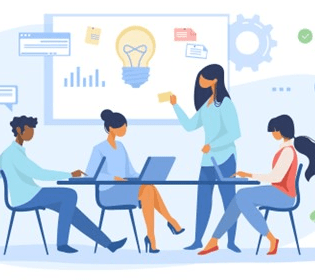Tips on Improving Group Assignments

Group assignments are a useful way to bring students together and give them important real-world experiences. They can take the form of projects, presentations, or collaborative papers.
Group work allows students to enhance their skills in working effectively with others (Bennett & Gadlin, 2012; Jackson et al., 2014). Weimer (2013) lists the advantages of learning through group work: The students develop a deeper understanding of the content through interaction, learn the behaviors that enhance group productivity, and how to collaborate with others.
Taylor (2011) argues that group work may improve learning and prepare the students for life experiences. An estimated 80% of all employees work in group settings (Attle & Baker, 2007). In the real world, employers are seeking candidates who not only have good grades but also possess effective oral and written communication skills, and the ability to work effectively within diverse groups (Finelli et al., 2011).
However, it is not always easy for students to be successful at group assignments and achieve collaborative learning benefits. Sometimes the group project turns out messy or even fails. Here are some problems instructors and students may face.
- Students in a group do not pull equal weight in the group project. Some students feel like they are doing most of the work, and others feel left out, or some students are free riders on the other students’ work.
- Students do not truly collaborate in group projects. Students simply divide up the tasks and work individually. The group project is just cobbled together.
- During the process of the project, compatibility issues will arise among students in the group.
Several strategies can be used to manage group projects that will ensure the group projects are successful.
To maximize success, start early in the semester. Instructors need to provide clear instructions for the group project. Each student should have clearly explained responsibilities and expectations along with established roles during the early stages of the project. Every student should be held accountable for their participation. Some possible roles could be group facilitator, recorder, presenter (spokesperson), and timekeeper. The facilitator helps to ensure group members work on assigned tasks and communicate well in the group. The recorder keeps a record of what is completed and who does it. The presenter or spokesperson presents the group work. The timekeeper regularly updates the timeline and makes sure group members stay on task.
If instructors give students some low-stake assignments or small collaborative activities to practice, then a group project later in the semester will seem much less daunting to students. Instructors need to design a group project that cannot be partitioned into independent parts, but rather clearly define roles, responsibilities, and expectations for students about how they will work together.
Instructors should set up a milestone for each stage of the group project and check the preliminary project outcomes before students deliver the final project. During the process of a group project, instructors should check in with groups periodically to ensure that students stay on task; along with providing guidance and support if any conflicts arise.
Group projects could also include individual reflections or peer reviews. These processes enable students to have a deeper insight into which parts were done as expected and which parts could be improved upon. This type of feedback could help guide instructors as they assign grades for the project. Grading expectations for the group project should be clear and include information on whether students are receiving individual grades for the project or one grade as a group.
If the instructor creates a group project for an online course in Canvas, a group work area can be made for students in each group to have their own discussion area, chat areas, and collaboration tools for communication and participation. An NSU learning and educational center video titled “Learning with the LEC: Canvas Student Groups” explains how to set up student groups in Canvas LMS. The workshop “Effective Use of Teams for Project Based Learning” hosted by LEC discussed how the group works enhance students’ learning engagement.
With proper planning, group projects are valuable experiences for students. A collaborative learning goal can be achieved through a well-built group project. Aside from the educational benefits, group work experience helps students prepare for their careers in the future.
References
Dzionek-Kozłowska, Joanna, and Tony Broadwick. “Incorporating Group Projects in E-Learning: Challenges for the Educators.” c3.icvl.eu/papers2017/icvl/documente/pdf/section1/section1_paper22.pdf. Accessed 14 July 2022.
Li-Shih Huang, Ph.D. “Students Riding on Coattails during Group Work? Five Simple Ideas to Try.” Faculty Focus. www.facultyfocus.com/articles/effective-teaching-strategies/students-riding-coattails-group-work-five-simple-ideas-try
“Assigning Roles for Group Work (Remote Learning)” Facing history Ourselves, October 2009, from www.facinghistory.org/resource-library/assigning-roles-group-work
